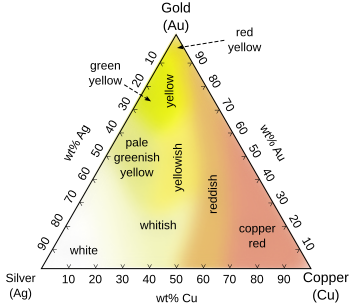
Back ذهب ملون Arabic রঙিন সোনা Bengali/Bangla Barevné zlato Czech Farvet guld Danish Χρωματισμένος χρυσός Greek Kolorigita oro Esperanto Oro coloreado Spanish طلای رنگی Persian Or coloré French זהב צבעוני HE

Colored gold is the name given to any gold that has been treated using techniques to change its natural color. Pure gold is slightly reddish yellow in color,[2] but colored gold can come in a variety of different colors by alloying it with different elements.
Colored golds can be classified in three groups:[3]: 118
- Alloys with silver and copper in various proportions, producing white, yellow, green and red golds. These are typically malleable alloys.
- Intermetallic compounds, producing blue and purple golds, as well as other colors. These are typically brittle, but can be used as gems and inlays.
- Surface treatments, such as oxide layers.
Pure 100% (in practice, 99.9% or better) gold is 24 karat by definition, so all colored golds are less pure than this, commonly 18K (75%), 14K (58.5%), 10K (41.6%), or 9K (37.5%).[4]
- ^ Woodrow Carpenter (June 1986). "Metals Suitable for Enameling". Glass on Metal Magazine. Archived from the original on 5 February 2017. Retrieved 17 November 2007.
- ^ Encyclopædia of Chemistry, theoretical, Practical, and Analytical: As Applied to the Arts and Manufactures. J. B. Lippincott & Company. 1880. pp. 70–.
- ^ Cretu, Cristian; van der Lingen, Elma (December 1999). "Coloured gold alloys" (PDF). Gold Bulletin. 32 (4): 115–126. doi:10.1007/BF03214796. Archived from the original (PDF) on 2018-07-30.
- ^ Cite error: The named reference
natbuildwas invoked but never defined (see the help page).